Gastric Bypass Surgery
A Step By Step Explanation
The operation may be performed by the laparoscopic technique (through 6 small incisions) or in rare instances, via the open technique (one vertical incision in the middle upper abdomen). The standard of care for gastric bypass is the laparoscopic technique, which offers tremendous advantages to the patient, but the operation is the same on the inside in either case. The illustrations you see below depict the procedure using laparoscopic instruments.
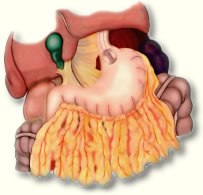
Measuring the Stomach
It is very important to measure the stomach accurately, to create a stomach “pouch” that is about ½ an ounce, or 15ml. This is done by running a soft, flexible tube, with an inflatable balloon on the end, through the mouth and into the stomach. The balloon is then inflated with 15ml of saline and slid up to the very top of the stomach.
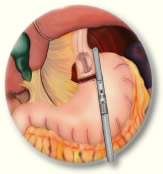
Dividing the Stomach with the Stapler
I then staple around the outside of the balloon. The stapler works by stapling on both sides, then cutting between the staple lines, so the stomach is sealed on both sides before division. This minimizes leakage and bleeding from cut edges. A series of “fires” with the stapler gets all the way across the stomach, until the stomach is completely divided into two separate pieces. The balloon is then deflated and removed.
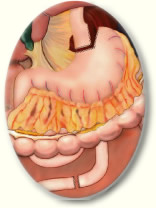
Dividing the Intestine
The “old” stomach is traced down to the small intestine, where it is divided and the “downstream” end is measured to 75cm. The end that is on the “stomach side” is attached into the side of the other limb, at the 75cm mark. (See below)
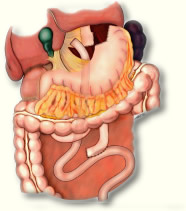
The 75cm limb is now delivered up behind the colon and the “old” stomach, to meet with the “new” stomach.
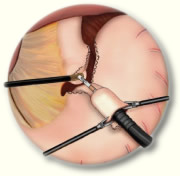
Making the Connection
A round stapler is introduced into the end of the intestine (this is called The Roux Limb) and the “anvil” of the stapler is separately passed through the mouth and pulled down into the little stomach pouch. The two pieces are united and clamped together. A circular staple line is fired, with a circular blade cutting a hole on the inside of the staples (like a hole-puncher). When you eat, the food will pass from the stomach, through the little 12mm hole, into the intestine. This staple line is then over sewn with sutures, like double stitching, and the connection is tested for leaks.
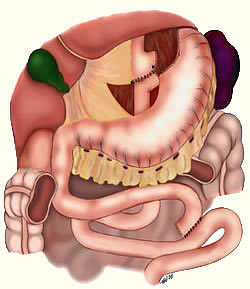
The small intestine just past the "old" stomach is connected into the other piece of small intestine, (this is the "Y" part of the Roux-en-Y) at the 75 cm mark. This allows for the acids and digestive enzymes from the "old" stomach to mix in with the food as it passes down from the new stomach, to allow for proper digestion.
When you eat a small amount of food, it will pass into the stomach pouch and when it does so, you will feel very full. As it passes into the intestine, you will immediately have a sense of satisfaction with that small amount of food. As it passes downstream, it will meet up with the acids and enzymes from the “old” stomach and normal digestion can occur throughout the rest of the digestive tract.
Click here to see a video of the surgery.
All drawings courtesy of Ethicon Endosurgery.

